

Risk Management and Enterprise Risk Management (July 2021) «Le risque politique est partout» Identifying and managing your biggest AI risks. Many organizations are generating significant value with artificial intelligence (AI) and recognize that this technology will shape the future.

At the same time, organizations are discovering that AI could expose them to a fast-changing universe of risks and ethical pitfalls that regulators signal they’ll be watching for—and potentially penalizing. Recently, the European Union proposed a set of AI regulations that, if violated, could result in material fines, and the US Federal Trade Commission (FTC) put out notice that it could hold organizations accountable for proliferating bias or inequities through AI. The CHALLENGE of imbalance. The Global Risks Report 2021. Derisking digital and analytics transformations. A bank was in the midst of a digital transformation, and the early stages were going well.
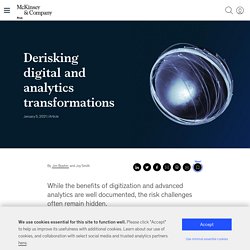
It had successfully transformed its development teams into agile squads, and leaders were thrilled with the resulting speed and productivity gains. But within weeks, leadership discovered that the software developers had been taking a process shortcut that left customer usernames and passwords vulnerable to being hacked. The transformation team fixed the issue, but then the bank experienced another kind of hack, which compromised the security of customer data. Some applications had been operating for weeks before errors were detected because no monitors were in place to identify security issues before deployment. This meant the bank did not know who might have had access to the sensitive customer data or how far and wide the data might have leaked. Risk, resilience, and rebalancing in global value chains. In recent decades, value chains have grown in length and complexity as companies expanded around the world in pursuit of margin improvements.
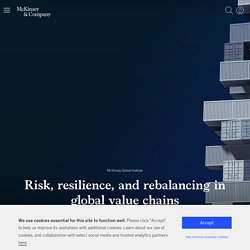
Since 2000, the value of intermediate goods traded globally has tripled to more than $10 trillion annually. Businesses that successfully implemented a lean, global model of manufacturing achieved improvements in indicators such as inventory levels, on-time-in-full deliveries, and shorter lead times. Is your board risk-ready? Your company’s board of directors is charged with reviewing all kinds of risks to the corporation.

But how well prepared are its members to do so? How ready are directors to evaluate, communicate, and act on risks — and thus to better ensure that their companies are doing a good job? A great deal rides on the answers to these questions. COVID-19: How should Risk functions respond? Impact on the people must remain the number one priority The biggest risk for banks remains their ability to operate in all potential scenarios of the outbreak.

Banks should continue to ensure the health and well-being of their employees, implementing and continually re-examining their business continuity plans. The use of technology to enable work to continue without physical proximity will be essential. Thoughts on a virus. I’ve been studying digital media “viruses” for more than 20 years, and much of what we have discovered about them comes from the analogy to epidemiology and the behavior of real viruses.
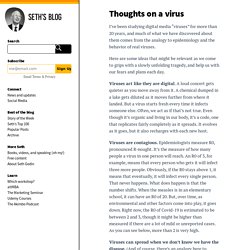
Here are some ideas that might be relevant as we come to grips with a slowly unfolding tragedy, and help us with our fears and plans each day. Viruses act like they are digital. A loud concert gets quieter as you move away from it. Nine cognitive biases risk managers should know. 01 Law of large numbers The godfather of bias detection is Daniel Kahneman, who won the Nobel prize for his work.
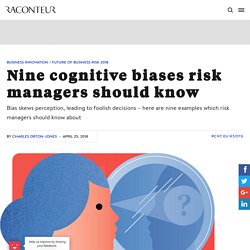
He revealed that intuition, even in matters we know a lot about, can be awful. For example, imagine two maternity hospitals, one large, one small. Containing the Coronavirus: What's the Risk to the Global Economy? On Monday, February 24, stock indices tumbled, spooked by reports that the coronavirus outbreak that emerged in China is spreading to countries including Italy, Iran and South Korea.
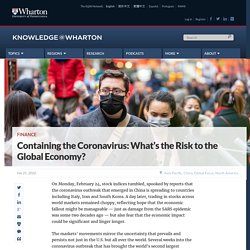
A day later, trading in stocks across world markets remained choppy, reflecting hope that the economic fallout might be manageable — just as damage from the SARS epidemic was some two decades ago — but also fear that the economic impact could be significant and linger longer. The markets’ movements mirror the uncertainty that prevails and persists not just in the U.S. but all over the world.
Several weeks into the coronavirus outbreak that has brought the world’s second largest economy to its knees, some of the most basic aspects of the virus remain unknown. It’s not yet clear how widely beyond China COVID-19 will spread; this week, numbers of infected individuals have surged outside China. Cyberrisk reporting and risk-based cybersecurity. Executives in all sectors have deepened their understanding of the dangers cyberrisk poses to their business.
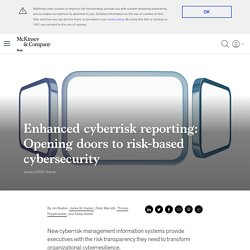
As hacks, cyberattacks, and data leaks proliferate in industry after industry, a holistic, enterprise-wide approach to cybersecurity has become a priority on board agendas. Companies are strengthening protections around their business models, core processes, and sensitive data. Nature Risk Rising: Why the Crisis Engulfing Nature Matters for Business and the Economy. Look out: Nature Risks on the Rise Nature loss is a planetary emergency.
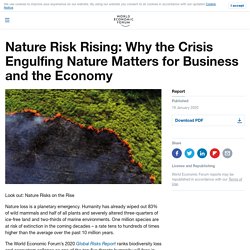
Humanity has already wiped out 83% of wild mammals and half of all plants and severely altered three-quarters of ice-free land and two-thirds of marine environments. One million species are at risk of extinction in the coming decades – a rate tens to hundreds of times higher than the average over the past 10 million years. The World Economic Forum’s 2020 Global Risks Report ranks biodiversity loss and ecosystem collapse as one of the top five threats humanity will face in the next ten years. The Global Risks Report 2020. For a list of shareable infographics, click here. For the 2020 Global Risks Report press release, click here. The 15th edition of the World Economic Forum’s Global Risks Report is published as critical risks are manifesting.
Climate risk and response. After more than 10,000 years of relative stability—the full span of human civilization—the Earth’s climate is changing. As average temperatures rise, climate science finds that acute hazards such as heat waves and floods grow in frequency and severity, and chronic hazards, such as drought and rising sea levels, intensify (Exhibit 1). In this report, we focus on understanding the nature and extent of physical risk from a changing climate over the next one to three decades, exploring physical risk as it is the basis of both transition and liability risks.
We strive to provide individuals with disabilities equal access to our website. If you would like information about this content we will be happy to work with you. Les 6 points chauds où éviter de faire des affaires en 2020. New report catalogs growing climate risks. Culture is key: 5 ways companies can avoid reputational risk. A toxic culture creates a variety of risks for a business.
From reputational damage brought on by revelations about employee conduct to the corrosive influence of issues around discrimination and employee wellbeing, a poor culture can rapidly sink a brand, particularly in an age when social media amplifies every misstep. Despite this, businesses are failing to read the warning signs. Can we no longer predict climate risk?
How often does a “one-in-a-hundred-year” storm occur? It’s not a trick question and it is something that is being asked repeatedly as the realities of climate change make themselves felt. The meteorological models of the past cannot predict the extent, intensity and frequency of extreme events in the future, and this presents a problem. Both insurance and climate modelling are numbers games: you roll the dice and know the chances that it will show a particular number. But when underwriting business assets in 21st century, not only are the dice no longer square, they are probably weighted and possibly magnetised. And the dots have been obliterated. The new behavioral science of risk taking in business. There’s something of a bull market in understanding attitudes toward risk. Last decade’s financial crisis spawned a slew of platforms — Riskalyze, FinaMetrica, Tolerisk, and a rapidly growing list of competitors — that seek to understand people’s tolerance for financial risk.
It is now common for financial advisors to ask clients a set of questions about how much money they’re willing to lose in exchange for the chance to make more. The advisors then use the answers to assign clients a risk number and match them to appropriate portfolios. How to Win the Next Economic Downturn. Addressing Cyber Risk through Cyber Resilience. Reputational risk: why companies have to take it seriously. Risky business: the importance of reputation (infographics) Weathering the storm: how to prepare for natural disaster risks. Protecting global supply chains from geopolitical risk. Risk roundtable: what the experts say. What is Fake News? Our Worry is Real. Five Fifty: The legacy threat. 2019 Risk in Review Study. 22nd CEO Survey: Risk trends 2019. Risk Agenda 2019. The Global Risks Report 2019. Would You Walk through Fire for Your Company?
McKinsey&Company. Global Risk Agility and Decision Making Organizational Resilience in the Era of Man Made Risk. Risk Management: What Every Leader Needs to Know. Mastering Catastrophic Risk: How Companies Are Coping with Disruption (2018) by Howard Kunreuther and Michael Useem. A 6-Part Tool for Ranking and Assessing Risks.